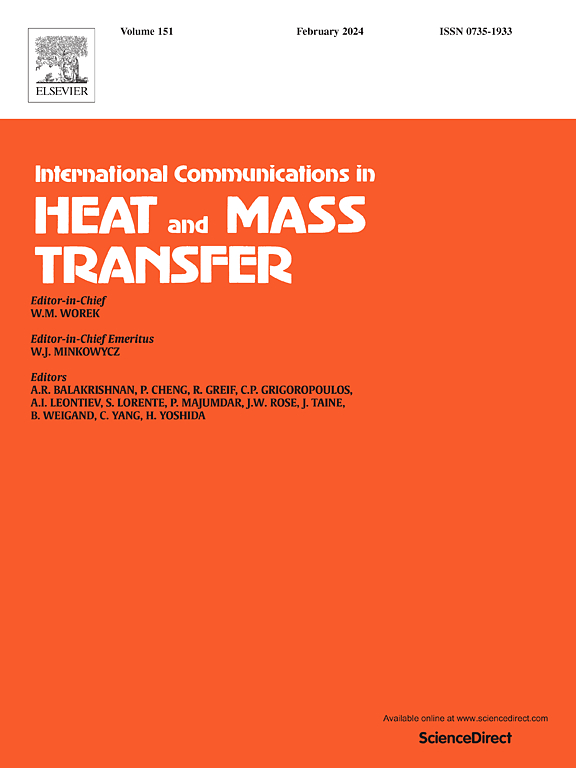Heat transfer characteristics of pulsatile flow through microchannel with heat-spots: Mimicking heat generation in the blood vessels
IF 6.4
2区 工程技术
Q1 MECHANICS
International Communications in Heat and Mass Transfer
Pub Date : 2024-11-11
DOI:10.1016/j.icheatmasstransfer.2024.108296
引用次数: 0
Abstract
Exploring the intricate interplay of heat transfer dynamics within two- and three-dimensional microchannels with static heat-spots, this study uncovers compelling insights into temperature distribution under varying wall conditions (adiabatic and constant wall temperature). The findings shed light on critical factors shaping heat transfer mechanisms. Key findings reveal that a channel with adiabatic walls experiences significantly higher temperatures than constant wall temperature cases, with a four-heat-spot configuration along the channel centerline yielding the highest temperatures. A stenosed channel experiences a larger temperature increase compared to the non-stenosed channel by a factor of 12–13 %. The study concludes with application to bio-fluid mechanics by studying hemodynamic condition in a bifurcated three-dimensional artery models. The location of heat-spots significantly influences the temperature distribution in the channel. A higher temperature rise appears in the case where heat-spot is located at the inlet of the narrower branch for the case of adiabatic wall conditions. These revelations hold promising implications for fields like medical science, where subtle temperature variations can indicate presence of inflammatory response in the blood vessel.
带有热斑的微通道脉动流的传热特性:模拟血管中的热量产生
这项研究探索了具有静态热斑的二维和三维微通道内热传导动力学的复杂相互作用,揭示了在不同壁面条件(绝热和恒定壁面温度)下温度分布的深刻见解。研究结果揭示了影响传热机制的关键因素。主要研究结果表明,绝热壁通道的温度明显高于恒定壁温情况,沿通道中心线的四个热斑配置产生的温度最高。狭窄通道的温度上升幅度比非狭窄通道大 12-13%。研究最后通过研究分叉三维动脉模型中的血液动力学状况,将其应用于生物流体力学。热斑的位置对通道内的温度分布有很大影响。在绝热壁条件下,如果热斑位于较窄分支的入口处,则温升较高。这些启示对医学等领域具有重要意义,因为微妙的温度变化可以表明血管中是否存在炎症反应。
本文章由计算机程序翻译,如有差异,请以英文原文为准。
求助全文
约1分钟内获得全文
求助全文
来源期刊
CiteScore
11.00
自引率
10.00%
发文量
648
审稿时长
32 days
期刊介绍:
International Communications in Heat and Mass Transfer serves as a world forum for the rapid dissemination of new ideas, new measurement techniques, preliminary findings of ongoing investigations, discussions, and criticisms in the field of heat and mass transfer. Two types of manuscript will be considered for publication: communications (short reports of new work or discussions of work which has already been published) and summaries (abstracts of reports, theses or manuscripts which are too long for publication in full). Together with its companion publication, International Journal of Heat and Mass Transfer, with which it shares the same Board of Editors, this journal is read by research workers and engineers throughout the world.

 求助内容:
求助内容: 应助结果提醒方式:
应助结果提醒方式:


